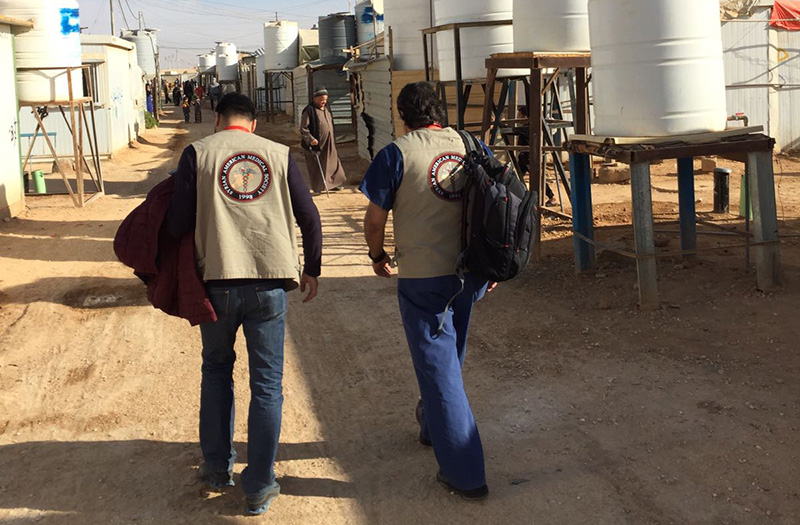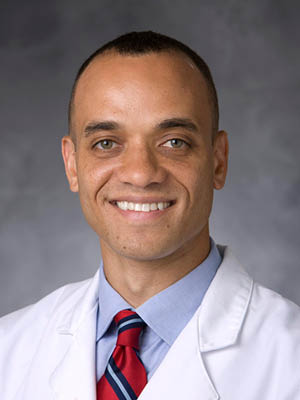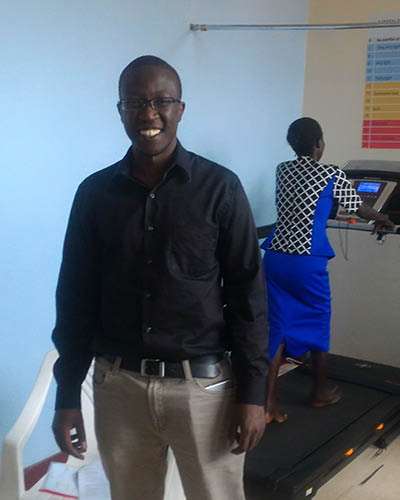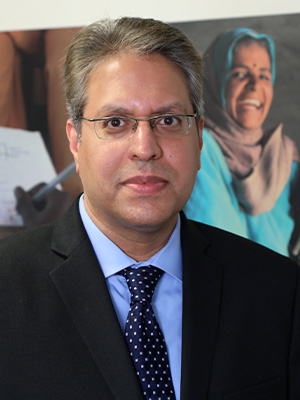
'A Pandemic in Slow Motion’: Duke Cardiologists Call for a New Approach to Prevent a Looming Global Crisis in Heart Health
An alarm buzzes Waseem Akhter, MD, awake at 6 a.m. A minivan picks him up at his hotel in Jordan. When he arrives at his destination, armed guards stand post outside the entrance. Akhter shows his travel documents and his vest, with a logo for the Syrian American Medical Society (SAMS), a global medical relief organization, before being waved through into a refugee camp.
It’s nearly 10 a.m. before Akhter, an interventional cardiologist and clinical associate in the Duke University School of Medicine's Department of Medicine, begins exams on refugees. The camp’s buildings usually don’t have air conditioning, and it’s 100 degrees outside. Akhter, who is also an adjunct assistant professor of global health in the Duke Global Health Institute, works with basic equipment: a computer, a small desk, and an ultrasound machine. He brings his own stethoscope, test strips, and glucose monitor from home. Some of the refugees hold their medical histories, scribbled on frayed paper.
“You had to sift through who had stress-related complaints, and who had a heart disease,” says Akhter who has worked at other camps in Greece and Lebanon since 2016. “Some had ailments of the heart before coming to the camp, and now they don’t have their medications. Now you’re trying to reintroduce medicines and provide good care to them.”
On such trips, Akhter has to be prepared for every medical scenario. Among refugees who have fled war and live in conditions prone to infectious diseases, chronic conditions such as heart disease are also a significant concern.
In 2017, on his very first day working with SAMS in Jordan, Akhter saw an elderly man who had owned a cheese shop in Daraa, Syria, before the war came. The man lost his first wife, his son, his home, and his business, and he fled to Jordan with his remaining family. By the time Akhter saw him, he had suffered chest pains for more than six months, caused by multiple blockages in blood vessels. The patient couldn’t afford the out-of-pocket expense of heart surgery. With funding from SAMS, Akhter performed a successful cardiac stent procedure at Gardens Hospital in Amman, Jordan — one of 63 cardiac catheterizations he and his colleagues performed during that mission trip.

Although Akhter was grateful to have been able to help the man and others like him, he remained haunted by the reality that "for every single patient I treat, there are likely hundreds that are not helped."
A Troubling Trend
Cardiovascular disease is the leading cause of death globally, claiming an estimated 17.9 million lives annually, the World Health Organization (WHO) reports. The WHO expects that figure to rise to more than 23 million deaths annually by 2030, and much of that increase will come from the developing world. More people in low- and middle-income countries eat more of the deadly triad — sweet, salty, and fatty foods — that are a huge factor in the chronic disease epidemic. Also, people are increasingly trading farming for sedentary jobs in cities. Researchers are seeing a direct impact on heart-related problems such as high blood pressure, stroke and heart failure.

“Global health is no longer only in the domain of infectious disease,” Akhter says. “Rising chronic illnesses will further burden health systems. This is like a pandemic in slow motion.”
Cardiologist Gerald Bloomfield, MD, an associate professor in the Duke School of Medicine and Duke Global Health Institute (DGHI), saw the trend firsthand in Kenya during the early 2000s. Now he helps direct a cardiology research collaboration between Duke and Moi University in Eldoret, Kenya.
“In the 1970s, there was a prevailing thought in medical literature Africans were immune to heart problems because it was seen so rarely,” Bloomfield says. “Now, we see more heart attacks there.” In fact, according to one study, heart disease rose by 81% in sub-Saharan Africa between 1990 and 2013.
“[In global health], we’re taught we’re going to treat patients with malnutrition, congenital abnormalities, or infectious diseases,” he says. “That was the spark for me to say, ‘There’s something going on in the global health space no one is doing anything about.’”
But the training program at Moi, launched in 2009 by Duke’s Hubert-Yeargan Center for Global Health as one of the first of its kind in sub-Saharan Africa, is working to change that. One cardiologist to come through the center, Titus Ng’eno, MD, is looking to advance a new way of thinking about cardiovascular disease, viewing it not just as a problem affecting individual patients, but as an urgent global health issue.
A Personal Connection

Ng’eno, one of Bloomfield’s mentees along with Akhter, has seen the rising toll of heart disease in his native Kenya. In 2013, he joined Duke as an internal medicine resident and later, as a student in DGHI’s Master of Science in Global Health (MSGH) program. He spent a year researching the impact of cardiovascular disease on patients in Western Kenya. Now, he’s an assistant professor of medicine in the Division of Cardiology, splitting his time between Duke and Moi Teaching and Referral Hospital in Eldoret.
Ng’eno says expanding access to cardiology treatment is important “because of how much more the burden of cardiovascular disease is expected to grow in the coming years. We need to think about [cardiovascular disease] from a broad sense that transcends geographic locations and silos of expertise.”
In 2015, DGHI reported up to 80 percent of heart disease-related deaths in sub-Saharan Africa could have been averted with the availability of critical or specialty care. At the time, only about a quarter of public health centers in Kenya could effectively treat cardiovascular disease.
That is changing, but Ng’eno says there are still considerable misunderstandings about the causes, symptoms, and treatments of heart disease. Unlike a fast-moving infection such as COVID-19, the damage from heart disease builds slowly over time and requires lifestyle changes and extended treatment.
“If it’s not killing you today or tomorrow, the urgency to treat it is often not as strong,” Ng’eno says. “What’s challenging about [heart disease] is that for the person who suffers a heart attack or stroke, it’s an emergency.”
To Treat Globally, Learn Globally
Akhter has also struggled with how little he can do for one patient in a single visit. Since 2010, he makes periodic trips to his native Pakistan, performing pro bono work at tertiary care hospitals in Lahore. Colleagues connect him with patients who don’t have health insurance and can’t afford procedures.
“Fix enough of their symptoms to get better,” Akhter says, “but if you do more than that, one patient may take up all your resources during a visit. Treatment has to be careful and strategic in low-resource settings.”
While on a medical mission in Greece in 2016, Akhter learned through a chance conversation about Duke’s MSGH program. He left his job as an assistant professor of medicine at the University of Massachusetts Medical School and enrolled at Duke. He juggled the course schedule with his already established career.
Since graduating in 2021, Akhter continues to see patients at Duke Cardiology of Cary within Duke Health. His work stateside and overseas includes placing balloons and stents in blocked heart arteries. The COVID-19 pandemic halted his medical missions overseas, which he’ll resume when traveling is safer. Meanwhile he seeks low-cost but effective solutions for people with cardiovascular disease or risk factors in regions with little wealth.
“How do you figure out what medications I can give in countries that can’t afford the latest and greatest things?" he said. "Can I provide them with something I know that works — on the penny — for heart disease, high blood pressure?”
He adds, “That’s the part that intellectually stimulated me.”
Managing Twin Crises

In one way, the rise of cardiovascular disease in low- and middle-income countries runs contrary to what you might expect to happen. As countries grow in wealth and education, health outcomes generally improve. But in 2021, Akhter, Bloomfield and Ng’eno wrote an article for the British Medical Journal, noting that while overall age-specific deaths decreased worldwide between 2007 and 2017, deaths from cardiovascular disease rose by 21% during the same period.
For many countries, increasing rates of cardiovascular disease are like a “double whammy,” as Akhter puts it, as many are still working to reduce high mortality rates from infectious diseases. In many of those places, resources and care for heart disease haven’t been able to keep up with the new demands.
“That is too rapid a transition for a health care system to develop an appropriate response,” Bloomfield says. “I became a cardiologist so that I could improve global health — focusing on the most vulnerable with heart disease. There’s heart disease in parts of the world where access to cardiologists and procedures aren’t there.”
Bloomfield says heart disease needs the same kind of concerted, collaborative multisectoral approach as history has seen with polio, measles, and now, COVID-19. Akhter and Ng’eno say one way to launch such an approach is to have more input from heart experts at the system level, helping shape policies and infrastructure to prevent heart disease in whole populations, rather than just one patient at a time.
Akhter says cardiologists need a seat at the table along with global health practitioners, taking part in discussions about treating heart disease internationally, nationally, and at the community level. “If you’re not at the table, you’re a spectator,” he says.
“Global health deals with everything like policy, laws, how drugs are sold, and how you train people,” Akhter says. Without that broad view, he says, his work can feel like putting a Band-Aid on a deep wound.
Because heart disease has many causes, it will take just as many — if not more — resources to lessen its global impact, the cardiologists say.
“A global health approach to cardiovascular disease is not singular: it’s concerted effort by many people,” says Ng’eno. “It needs to be a collaborative undertaking, and only then will we shift the tide. With new models of care delivery and advances in research, I think we can mitigate the global impact of cardiovascular disease. We can help reduce [heart disease] substantially.”
Alicia Banks is a Senior Public Relations Specialist in the Duke Global Health Institute.
Photos and video by Jim Rogalski, senior video and multimedia producer in the School of Medicine's Office of Strategic Communications.
